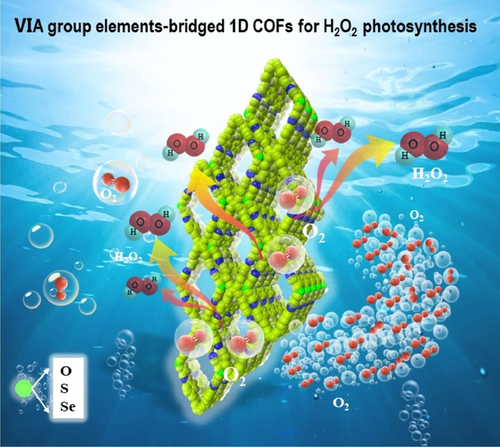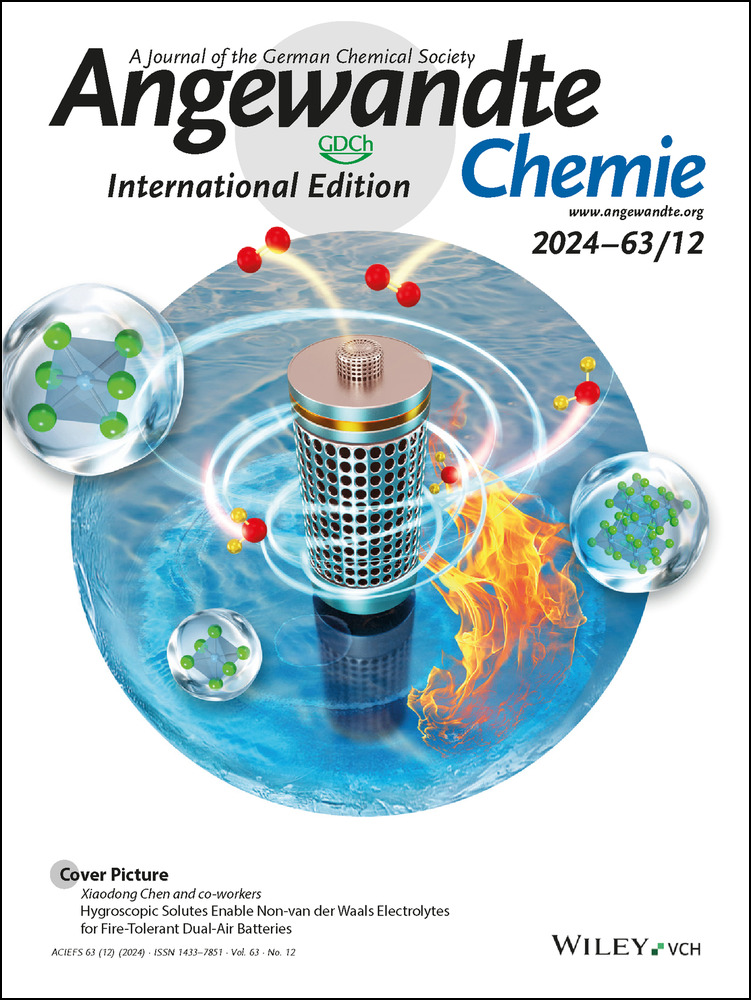1D Covalent Organic Frameworks Triggering Highly Efficient Photosynthesis of H2O2 via Controllable Modular Design
Dr. Panjie Li
Key Laboratory of Environmental Remediation and Ecological Health, Ministry of Industry and Information Technology, School of Environmental and Biological Engineering, Nanjing University of Science and Technology, Nanjing, 210094 PR China
These authors contributed equally to this work.
Search for more papers by this authorDr. Feiyue Ge
School of Chemistry and Chemical Engineering, Nanjing University, Nanjing, 210008 PR China
These authors contributed equally to this work.
Search for more papers by this authorCorresponding Author
Prof. Yong Yang
School of Chemistry and Chemical Engineering, Nanjing University of Science and Technology, Nanjing, 210094 PR China
Search for more papers by this authorTianyu Wang
Key Laboratory of Environmental Remediation and Ecological Health, Ministry of Industry and Information Technology, School of Environmental and Biological Engineering, Nanjing University of Science and Technology, Nanjing, 210094 PR China
Search for more papers by this authorXiaoyue Zhang
Key Laboratory of Environmental Remediation and Ecological Health, Ministry of Industry and Information Technology, School of Environmental and Biological Engineering, Nanjing University of Science and Technology, Nanjing, 210094 PR China
Search for more papers by this authorCorresponding Author
Prof. Kan Zhang
MIIT Key Laboratory of Advanced Display Material and Devices, School of Materials Science and Engineering, Nanjing University of Science and Technology, Nanjing, 210094 PR China
Search for more papers by this authorCorresponding Author
Prof. Jinyou Shen
Key Laboratory of Environmental Remediation and Ecological Health, Ministry of Industry and Information Technology, School of Environmental and Biological Engineering, Nanjing University of Science and Technology, Nanjing, 210094 PR China
Search for more papers by this authorDr. Panjie Li
Key Laboratory of Environmental Remediation and Ecological Health, Ministry of Industry and Information Technology, School of Environmental and Biological Engineering, Nanjing University of Science and Technology, Nanjing, 210094 PR China
These authors contributed equally to this work.
Search for more papers by this authorDr. Feiyue Ge
School of Chemistry and Chemical Engineering, Nanjing University, Nanjing, 210008 PR China
These authors contributed equally to this work.
Search for more papers by this authorCorresponding Author
Prof. Yong Yang
School of Chemistry and Chemical Engineering, Nanjing University of Science and Technology, Nanjing, 210094 PR China
Search for more papers by this authorTianyu Wang
Key Laboratory of Environmental Remediation and Ecological Health, Ministry of Industry and Information Technology, School of Environmental and Biological Engineering, Nanjing University of Science and Technology, Nanjing, 210094 PR China
Search for more papers by this authorXiaoyue Zhang
Key Laboratory of Environmental Remediation and Ecological Health, Ministry of Industry and Information Technology, School of Environmental and Biological Engineering, Nanjing University of Science and Technology, Nanjing, 210094 PR China
Search for more papers by this authorCorresponding Author
Prof. Kan Zhang
MIIT Key Laboratory of Advanced Display Material and Devices, School of Materials Science and Engineering, Nanjing University of Science and Technology, Nanjing, 210094 PR China
Search for more papers by this authorCorresponding Author
Prof. Jinyou Shen
Key Laboratory of Environmental Remediation and Ecological Health, Ministry of Industry and Information Technology, School of Environmental and Biological Engineering, Nanjing University of Science and Technology, Nanjing, 210094 PR China
Search for more papers by this authorGraphical Abstract
A sequence of novel VIA group elements (O, S, Se)-bridged 1D COFs with typical 4-c sql topology were synthesized and applied as catalysts in the photosynthesis of H2O2. Thanks to their 1D configurations, more active sites are accessible, the proton interlaminar shuttle are accelerated, and the directional transfer of electrons is also improved. The bridge-atoms (O, S, Se) in the 1D COFs play a crucial role for the catalytic activity and selectivity.
Abstract
The topological diversity of covalent organic frameworks (COFs) enables considerable space for exploring their structure-performance relationships. In this study, we report a sequence of novel 1D COFs (EO, ES, and ESe-COF) with typical 4-c sql topology that can be interconnected with VIA group elements (O, S, and Se) via a modular design strategy. It is found that the electronic structures, charge delivery property, light harvesting ability, and hydrophilicity of these 1D COFs can be profoundly influenced by the bridge-linked atom ordinal. Finally, EO-COF, possessing the highest quantity of active sites, the longest lifetime of the active electron, the strongest interaction with O2, and the lowest energy barrier of O2 reduction, exhibits exceptional photocatalytic O2-to-H2O2 activity under visible light, with a production rate of 2675 μmol g−1 h−1 and a high apparent quantum yield of 6.57 % at 450 nm. This is the first systematic report on 1D COFs for H2O2 photosynthesis, which enriches the topological database in reticular chemistry and promotes the exploration of structure-catalysis correlation.
Conflict of interests
The authors declare no conflict of interest.
Open Research
Data Availability Statement
The data that support the findings of this study are available from the corresponding author upon reasonable request.
Supporting Information
As a service to our authors and readers, this journal provides supporting information supplied by the authors. Such materials are peer reviewed and may be re-organized for online delivery, but are not copy-edited or typeset. Technical support issues arising from supporting information (other than missing files) should be addressed to the authors.
| Filename | Description |
|---|---|
| anie202319885-sup-0001-misc_information.pdf4.6 MB | Supporting Information |
Please note: The publisher is not responsible for the content or functionality of any supporting information supplied by the authors. Any queries (other than missing content) should be directed to the corresponding author for the article.
References
- 1K. Geng, T. He, R. Liu, S. Dalapati, K. T. Tan, Z. Li, S. Tao, Y. Gong, Q. Jiang, D. Jiang, Chem. Rev. 2020, 120, 8814–8933.
- 2Q. Guan, L.-L. Zhou, Y.-B. Dong, Chem. Soc. Rev. 2022, 51, 6307–6416.
- 3X. Zhao, P. Pachfule, A. Thomas, Chem. Soc. Rev. 2021, 50, 6871–6913.
- 4
- 4aH. L. Nguyen, C. Gropp, O. M. Yaghi, J. Am. Chem. Soc. 2020, 142, 2771–2776;
- 4bX. Guan, F. Chen, S. Qiu, Q. Fang, Angew. Chem. Int. Ed. 2022, 62. e202213203.
- 5
- 5aB. Gui, J. Xin, Y. Cheng, Y. Zhang, G. Lin, P. Chen, J.-X. Ma, X. Zhou, J. Sun, C. Wang, J. Am. Chem. Soc. 2023, 145, 11276–11281;
- 5bX. Guan, Q. Fang, Y. Yan, S. Qiu, Acc. Chem. Res. 2022, 55, 1912–1927.
- 6S. An, X. Li, S. Shang, T. Xu, S. Yang, C. X. Cui, C. Peng, H. Liu, Q. Xu, Z. Jiang, J. Hu, Angew. Chem. Int. Ed. 2023, 62. e202218742.
- 7L. Zou, Z. A. Chen, D. H. Si, S. L. Yang, W. Q. Gao, K. Wang, Y. B. Huang, R. Cao, Angew. Chem. Int. Ed. 2023. e202309820.
- 8
- 8aY. Meng, Y. Luo, J. L. Shi, H. Ding, X. Lang, W. Chen, A. Zheng, J. Sun, C. Wang, Angew. Chem. Int. Ed. 2020, 59, 3624–3629;
- 8bK. Wang, X. Kang, C. Yuan, X. Han, Y. Liu, Y. Cui, Angew. Chem. Int. Ed. 2021, 60, 19466–19476.
- 9
- 9aZ. Chen, K. Wang, Y. Tang, L. Li, X. Hu, M. Han, Z. Guo, H. Zhan, B. Chen, Angew. Chem. Int. Ed. 2022, 62, e202213268;
- 9bM. Zhang, R. Zheng, Y. Ma, R. Chen, X. Sun, X. Sun, Molecules 2019, 24, doi: 10.3390/molecules24183361.
- 10P. Li, Y. Yang, Z. Ling, Z. Fang, Q. Deng, B. Zhou, Q. Zhong, J. Shen, Appl. Catal. B 2022, 318, 121782.
- 11T. He, Y. Zhao, Angew. Chem. Int. Ed. 2023, 62, e202303086.
- 12S. Yao, X. Zhao, X. Wan, X. Wang, T. Huang, J. Zhang, L. Li, Mater. Horiz. 2021, 8, 3457–3467.
- 13M. Yang, H. Hanayama, L. Fang, M. A. Addicoat, Y. Guo, R. Graf, K. Harano, J. Kikkawa, E. Jin, A. Narita, K. Müllen, J. Am. Chem. Soc. 2023, 145, 14417–14426.
- 14
- 14aC. Gong, Z. Liu, Z. Tao, A. Xu, H. Xie, Q. Fang, Z. Qiu, Y. Yan, ACS Sustainable Chem. Eng. 2023, 11, 4789–4799;
- 14bW. Cao, F. Dai, R. Hu, B. Z. Tang, J. Am. Chem. Soc. 2020, 142, 978–986;
- 14cQ. Li, S. Liu, M. Xu, X. Pan, N. Li, J. Zhu, X. Zhu, Eur. Polym. J. 2020, 122, 109358.
- 15P. Das, G. Chakraborty, J. Roeser, S. Vogl, J. Rabeah, A. Thomas, J. Am. Chem. Soc. 2023, 145, 2975–2984.
- 16X. T. Li, J. Zou, T. H. Wang, H. C. Ma, G. J. Chen, Y. B. Dong, J. Am. Chem. Soc. 2020, 142, 6521–6526.
- 17J. Sun, H. Sekhar Jena, C. Krishnaraj, K. Singh Rawat, S. Abednatanzi, J. Chakraborty, A. Laemont, W. Liu, H. Chen, Y. Y. Liu, K. Leus, H. Vrielinck, V. Van Speybroeck, P. Van Der Voort, Angew. Chem. Int. Ed. 2023, 62, e202216719.
- 18C. Qin, Y. Yang, X. Wu, L. Chen, Z. Liu, L. Tang, L. Lyu, D. Huang, D. Wang, C. Zhang, X. Yuan, W. Liu, H. Wang, Nat. Commun. 2023, 14, doi:10.1038/s41467-023-42513-x.
- 19
- 19aH. Zhang, Z. Lin, P. Kidkhunthod, J. Guo, Angew. Chem. Int. Ed. 2023, 62, e202217527;
- 19bX. Dong, F. Huang, Y. Wang, K. Zhang, X. Lang, Mater. Today. Energy. 2023, 38, 101443.
- 20
- 20aJ. N. Chang, J. W. Shi, Q. Li, S. Li, Y. R. Wang, Y. Chen, F. Yu, S. L. Li, Y. Q. Lan, Angew. Chem. Int. Ed. 2023, 62, e202303606;
- 20bT.-Y. Yu, Q. Niu, Y. Chen, M. Lu, M. Zhang, J.-W. Shi, J. Liu, Y. Yan, S.-L. Li, Y.-Q. Lan, J. Am. Chem. Soc. 2023, 145, 8860–8870.
- 21
- 21aF. Li, X. Yue, D. Zhang, J. Fan, Q. Xiang, Appl. Catal. B 2021, 292, 120179;
- 21bK. Wang, H. Qin, J. Li, Q. Cheng, Y. Zhu, H. Hu, J. Peng, S. Chen, G. Wang, S. Chou, S. Dou, Y. Xiao, Appl. Catal. B 2023, 332, 122763;
- 21cJ. Tang, X. Li, Y. Ma, K. Wang, Z. Liu, Q. Zhang, Appl. Catal. B 2023, 327, 122417.
- 22J. Zhang, B. Zhu, L. Zhang, J. Yu, Chem. Commun. 2023, 59, 688–699.
- 23F. M. Zhang, J. L. Sheng, Z. D. Yang, X. J. Sun, H. L. Tang, M. Lu, H. Dong, F. C. Shen, J. Liu, Y. Q. Lan, Angew. Chem. Int. Ed. 2018, 57, 12106–12110.
- 24Y. Yang, N. Luo, S. Lin, H. Yao, Y. Cai, ACS Catal. 2022, 12, 10718–10726.
- 25X. Li, S. Yang, M. Liu, X. Yang, Q. Xu, G. Zeng, Z. Jiang, Angew. Chem. Int. Ed. 2023, 62, e202301865.
- 26L. Li, X. Huo, S. Chen, Q. Luo, W. Wang, Y. Wang, N. Wang, Small 2023, doi: 10.1002/smll.202301865.
- 27L. Zhou, J. Feng, B. Qiu, Y. Zhou, J. Lei, M. Xing, L. Wang, Y. Zhou, Y. Liu, J. Zhang, Appl. Catal. B 2020, 267, 118396.
- 28H. Wang, C. Yang, F. Chen, G. Zheng, Q. Han, Angew. Chem. Int. Ed. 2022, 61, e202202328.
- 29
- 29aL. Chen, H. Li, H. Li, H. Li, W. Qi, Q. Zhang, J. Zhu, P. Zhao, S. Yang, Appl. Catal. B 2022, 318, 121863;
- 29bX. Shi, L. Wang, W. Dai, X. a. Dong, Y. Bai, L. Ye, ACS Catal. 2023, 13, 5264–5271;
- 29cY. Zhang, S. Sayed, L. Kang, M. Sanger, T. Wiegand, P. Jessop, S. DeBeer, A. Bordet, W. Leitner, Proc. Natl. Acad. Sci. USA 2023, 120, e2215305120.
- 30X. Jiang, Z. Zhang, M. Sun, W. Liu, J. Huang, H. Xu, Appl. Catal. B 2021, 281, 119473.
- 31
- 31aS. Huang, B. Zhang, D. Wu, Y. Xu, H. Hu, F. Duan, H. Zhu, M. Du, S. Lu, Appl. Catal. B 2024, 340, 123216;
- 31bS. Li, B. Feng, X. Zhang, J. Tian, D. Wang, Y. Pei, M. Qiao, Y. Li, B. Zong, Appl. Catal. B 2023, 335, 122879.
- 32K. Zhang, M. Dan, J. Yang, F. Wu, L. Wang, H. Tang, Z. Q. Liu, Adv. Funct. Mater. 2023, 33, e202302964.
- 33J. Y. Yue, L. P. Song, Y. F. Fan, Z. X. Pan, P. Yang, Y. Ma, Q. Xu, B. Tang, Angew. Chem. Int. Ed. 2023, 62, e202309624.





